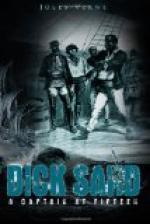In fact, the five blacks which the “Waldeck” carried belonged to the State of Pennsylvania. The oldest, sold in Africa as a slave at the age of six years, then brought to the United States, had been freed already many years ago by the Emancipation Proclamation. As to his companions, much younger than he, sons of slaves liberated before their birth, they were born free; no white had ever had the right of property over them. They did not even speak that “negro” language, which does not use the article, and only knows the infinitive of the verbs—a language which has disappeared little by little, indeed, since the anti-slavery war. These blacks had, then, freely left the United States, and they were returning to it freely.
As they told Captain Hull, they were engaged as laborers at an Englishman’s who owned a vast mine near Melbourne, in Southern Australia. There they had passed three years, with great profit to themselves; their engagement ended, they had wished to return to America.
They then had embarked on the “Waldeck,” paying their passage like ordinary passengers. On the 5th of December they left Melbourne, and seventeen days after, during a very black night, the “Waldeck” had been struck by a large steamer.
The blacks were in bed. A few seconds after the collision, which was terrible, they rushed on the deck.
Already the ship’s masts had fallen, and the “Waldeck” was lying on the side; but she would not sink, the water not having invaded the hold sufficiently to cause it.
As to the captain and crew of the “Waldeck,” all had disappeared, whether some had been precipitated into the sea, whether others were caught on the rigging of the colliding ship, which, after the collision, had fled to return no more.
The five blacks were left alone on board, on a half-capsized hull, twelve hundred miles from any land.
Then oldest of the negroes was named Tom. His age, as well as his energetic character, and his experience, often put to the proof during a long life of labor, made him the natural head of the companions who were engaged with him.
The other blacks were young men from twenty-five to thirty years old, whose names were Bat (abbreviation of Bartholomew), son of old Tom, Austin, Acteon, and Hercules, all four well made and vigorous, and who would bring a high price in the markets of Central Africa. Even though they had suffered terribly, one could easily recognize in them magnificent specimens of that strong race, on which a liberal education, drawn from the numerous schools of North America, had already impressed its seal.
Tom and his companions then found themselves alone on the “Waldeck” after the collision, having no means of raising that inert hull, without even power to leave it, because the two boats on board had been shattered in the boarding. They were reduced to waiting for the passage of a ship, while the wreck drifted little by little under the action of the currents. This action explained why she had been encountered so far out of her course, for the “Waldeck,” having left Melbourne, ought to be found in much lower latitude.




